Cotton Cultivation in Greece under Sustainable Utilization of Inputs
Abstract
:1. Introduction
2. Materials and Methods
2.1. Genetic Material and Experimental Design
2.2. Cultivation Practices
2.3. Cotton Harvesting and Evaluation of Technological Characteristics
2.4. Statistical Analysis
3. Results
3.1. Growth Conditions
3.2. Evaluation of Effects
3.3. Seed Cotton Yield
3.4. Fiber Content
3.5. Length Parameters
3.6. Micronaire
3.7. Elongation and Strength
3.8. Color Parameters
4. Discussion
5. Conclusions
Author Contributions
Funding
Institutional Review Board Statement
Informed Consent Statement
Data Availability Statement
Acknowledgments
Conflicts of Interest
References
- Pabuayon, I.L.B.; Kelly, B.R.; Mitchell-McCallister, D.; Coldren, C.L.; Ritchie, G.L. Cotton Boll Distribution: A Review. Agron. J. 2021, 113, 956–970. [Google Scholar] [CrossRef]
- Wiggins, M.S.; Leib, B.G.; Mueller, T.C.; Main, C.L. Investigation of Physiological Growth, Fiber Quality, Yield, and Yield Stability of Upland Cotton Varieties in Differing Environments. J. Cotton Sci. 2013, 17, 9. [Google Scholar]
- Wu, B.; Zuo, W.; Yang, P.; Zhang, W. Optimal Water and Nitrogen Management Increases Cotton Yield through Improving Leaf Number and Canopy Light Environment. Field Crops Res. 2023, 290, 108745. [Google Scholar] [CrossRef]
- Loka, D.; Oosterhuis, D.M. Water Stress and Reproductive Development in Cotton. In Flowering and Fruiting in Cotton; Oosterhuis, D.M., Cothren, J.T., Eds.; Cotton Foundation: Memphis, TN, USA, 2012; pp. 51–57. [Google Scholar]
- Koudahe, K.; Sheshukov, A.Y.; Aguilar, J.; Djaman, K. Irrigation-Water Management and Productivity of Cotton: A Review. Sustainability 2021, 13, 10070. [Google Scholar] [CrossRef]
- Snowden, M.C.; Ritchie, G.L.; Simao, F.R.; Bordovsky, J.P. Timing of Episodic Drought Can Be Critical in Cotton. Agron. J. 2014, 106, 452–458. [Google Scholar] [CrossRef]
- Pettigrew, W.T. The Effect of Higher Temperatures on Cotton Lint Yield Production and Fiber Quality. Crop Sci. 2008, 48, 278–285. [Google Scholar] [CrossRef]
- Voloudakis, A.E.; Kosmas, S.A.; Tsakas, S.; Eliopoulos, E.; Loukas, M.; Kosmidou, K. Expression of Selected Drought-Related Genes and Physiological Response of Greek Cotton Varieties. Funct. Plant Biol. 2002, 29, 1237–1245. [Google Scholar] [CrossRef] [PubMed]
- Shukr, H.H.; Pembleton, K.G.; Zull, A.F.; Cockfield, G.J. Impacts of Effects of Deficit Irrigation Strategy on Water Use Efficiency and Yield in Cotton under Different Irrigation Systems. Agronomy 2021, 11, 231. [Google Scholar] [CrossRef]
- Ahmad, H.S.; Imran, M.; Ahmad, F.; Rukh, S.; Ikram, R.M.; Rafique, H.M.; Iqbal, Z.; Alsahli, A.A.; Alyemeni, M.N.; Ali, S.; et al. Improving Water Use Efficiency through Reduced Irrigation for Sustainable Cotton Production. Sustainability 2021, 13, 4044. [Google Scholar] [CrossRef]
- Kang, Y.; Wang, R.; Wan, S.; Hu, W.; Jiang, S.; Liu, S. Effects of Different Water Levels on Cotton Growth and Water Use through Drip Irrigation in an Arid Region with Saline Ground Water of Northwest China. Agric. Water Manag. 2012, 109, 117–126. [Google Scholar] [CrossRef]
- Papastylianou, P.T.; Argyrokastritis, I.G. Effect of Limited Drip Irrigation Regime on Yield, Yield Components, and Fiber Quality of Cotton under Mediterranean Conditions. Agric. Water Manag. 2014, 142, 127–134. [Google Scholar] [CrossRef]
- Pabuayon, I.L.B.; Mitchell-McCallister, D.; Lewis, K.L.; Ritchie, G.L. Yield and Economic Response of Modern Cotton Cultivars to Nitrogen Fertilizer. Agronomy 2021, 11, 2149. [Google Scholar] [CrossRef]
- Pokhrel, A.; Snider, J.L.; Virk, S.; Sintim, H.Y.; Hand, L.C.; Vellidis, G.; Parkash, V.; Chalise, D.P.; Lee, J.M. Quantifying Physiological Contributions to Nitrogen-Induced Yield Variation in Field-Grown Cotton. Field Crops Res. 2023, 299, 108976. [Google Scholar] [CrossRef]
- Chen, J.; Liu, L.; Wang, Z.; Sun, H.; Zhang, Y.; Bai, Z.; Song, S.; Lu, Z.; Li, C. Nitrogen Fertilization Effects on Physiology of the Cotton Boll–Leaf System. Agronomy 2019, 9, 271. [Google Scholar] [CrossRef]
- Clement, J.D.; Constable, G.A.; Stiller, W.N.; Liu, S.M. Negative Associations Still Exist between Yield and Fibre Quality in Cotton Breeding Programs in Australia and USA. Field Crops Res. 2012, 128, 1–7. [Google Scholar] [CrossRef]
- Giannakopoulos, C.; Kostopoulou, E.; Varotsos, K.V.; Tziotziou, K.; Plitharas, A. An Integrated Assessment of Climate Change Impacts for Greece in the near Future. Reg. Environ. Change 2011, 11, 829–843. [Google Scholar] [CrossRef]
- Clark, M.; Tilman, D. Comparative Analysis of Environmental Impacts of Agricultural Production Systems, Agricultural Input Efficiency, and Food Choice. Environ. Res. Lett. 2017, 12, 064016. [Google Scholar] [CrossRef]
- Engonopoulos, V.; Kouneli, V.; Mavroeidis, A.; Karydogianni, S.; Beslemes, D.; Kakabouki, I.; Papastylianou, P.; Bilalis, D. Cotton versus Climate Change: The Case of Greek Cotton Production. Not. Bot. Horti Agrobot. Cluj-Napoca 2021, 49, 12547. [Google Scholar] [CrossRef]
- Tsaliki, E.; Kalyvas, A. Cotton Research Aspects in Greece. In Proceedings of the 12th Meeting of Inter-Regional Research Network on Cotton, Sharm El Sheikh, Egypt, 6–10 October 2015; Available online: https://staging.icac.org/getattachment/tech/Regional-Networks/Inter-Regional-Cooperative-Research-Network-on-Cot/Twelfth-Regional-Meeting-Documents/E-Tsaliki.pdf (accessed on 9 November 2023).
- ICAC Cotton Data Book. 2021. Available online: https://Icac.org/Content/PublicationsPdf%20Files/941868ca_bd5c_406f_9a0c_3d5862fa1539/Contents-DataBook.Pdf.Pdf (accessed on 9 November 2023).
- Katerji, N.; Mastrorilli, M.; Rana, G. Water Use Efficiency of Crops Cultivated in the Mediterranean Region: Review and Analysis. Eur. J. Agron. 2008, 28, 493–507. [Google Scholar] [CrossRef]
- Cramer, W.; Guiot, J.; Fader, M.; Garrabou, J.; Gattuso, J.-P.; Iglesias, A.; Lange, M.A.; Lionello, P.; Llasat, M.C.; Paz, S.; et al. Climate Change and Interconnected Risks to Sustainable Development in the Mediterranean. Nat. Clim. Change 2018, 8, 972–980. [Google Scholar] [CrossRef]
- Feng, L.; Mathis, G.; Ritchie, G.; Han, Y.; Li, Y.; Wang, G.; Zhi, X.; Bednarz, C.W. Optimizing Irrigation and Plant Density for Improved Cotton Yield and Fiber Quality. Agron. J. 2014, 106, 1111–1118. [Google Scholar] [CrossRef]
- Tsiros, E.; Domenikiotis, C.; Dalezios, N.R. Assessment of Cotton Phenological Stages Using Agroclimatic Indices: An Innovative Approach. Ital. J. Agrometeorol. 2009, 1, 50–55. [Google Scholar]
- Zhang, D.; Luo, Z.; Liu, S.; Li, W.; Dong, H. Effects of Deficit Irrigation and Plant Density on the Growth, Yield and Fiber Quality of Irrigated Cotton. Field Crops Res. 2016, 197, 1–9. [Google Scholar] [CrossRef]
- Kalivas, A.; Xanthopoulos, F.; Kehagia, O.; Tsaftaris, A.S. Agronomic Characterization, Genetic Diversity and Association Analysis of Cotton Cultivars Using Simple Sequence Repeat Molecular Markers. Genet. Mol. Res. 2011, 10, 208–217. [Google Scholar] [CrossRef]
- ASTM D 5867 “Standard Test Methods for Measurement of Physical Properties of Cotton Fibers by High Volume Instruments” (Current Version: 2012). Available online: https://cdn.standards.iteh.ai/samples/5743/d40628537bfe41f6b5e2953b22df9562/ASTM-D4604-95.pdf (accessed on 9 November 2023).
- Delhom, C.D.; Martin, V.B.; Schreiner, M.K. Textile Industry Needs. J. Cotton Sci. 2017, 21, 210–219. [Google Scholar] [CrossRef]
- R Core Team. R: A Language and Environment for Statistical Computing; R Foundation for Statistical Computing: Vienna, Austria, 2022. [Google Scholar]
- Kuznetsova, A.; Brockhoff, P.B.; Christensen, R.H.B. lmerTest Package: Tests in Linear Mixed Effects Models. J. Stat. Softw. 2017, 82, 1–26. [Google Scholar] [CrossRef]
- Lenth, R.V. Emmeans: Estimated Marginal Means, Aka Least-Squares Means. 2022. Available online: https://cran.r-project.org/web/packages/emmeans/emmeans.pdf (accessed on 9 November 2023).
- Hothorn, T.; Bretz, F.; Westfall, P. Simultaneous Inference in General Parametric Models. Biom. J. 2008, 50, 346–363. [Google Scholar] [CrossRef]
- Dowle, M.; Srinivasan, A. Data.Table: Extension of ‘data.Frame’. 2022. Available online: https://rdrr.io/cran/data.table/ (accessed on 9 November 2023).
- Wickham, H.; François, R.; Henry, L.; Müller, K. Dplyr: A Grammar of Data Manipulation. 2022. Available online: https://cran.r-project.org/web/packages/dplyr/index.html (accessed on 9 November 2023).
- Wickham, H. Ggplot2: Elegant Graphics for Data Analysis; Springer: New York, NY, USA, 2016; ISBN 978-3-319-24277-4. [Google Scholar]
- Tsaliki, E.; Panoras, Y.; Grigoriadis, I.; Loison, R. Cotton Experimental Dataset for Modeling Cultivar * Irrigation * Fertilization Interactions in Greece from 2018 to 2020. 2022. Available online: https://dataverse.cirad.fr/dataset.xhtml?persistentId=doi:10.18167/DVN1/XQU8ZF (accessed on 9 November 2023).
- Sharma, R.K.; Kumar, S.; Vatta, K.; Dhillon, J.; Reddy, K.N. Impact of Recent Climate Change on Cotton and Soybean Yields in the Southeastern United States. J. Agric. Food Res. 2022, 9, 100348. [Google Scholar] [CrossRef]
- Mauget, S.; Ulloa, M.; Dever, J. Planting Date Effects on Cotton Lint Yield and Fiber Quality in the U.S. Southern High Plains. Agriculture 2019, 9, 82. [Google Scholar] [CrossRef]
- Lokhande, S.; Reddy, K.R. Reproductive and Fiber Quality Responses of Upland Cotton to Moisture Deficiency. Agron. J. 2014, 106, 1060–1069. [Google Scholar] [CrossRef]
- Delhom, C.D.; Kelly, B.; Martin, V. Physical Properties of Cotton Fiber and Their Measurement. In Cotton Fiber: Physics, Chemistry and Biology; Fang, D.D., Ed.; Springer International Publishing: Cham, Switzerland, 2018; pp. 41–73. ISBN 978-3-030-00871-0. [Google Scholar]
- Matusiak, M. Digieye Application in Cotton Colour Measurement. Autex Res. J. 2015, 15, 77–86. [Google Scholar] [CrossRef]
- Liakatas, A.; Roussopoulos, D.; Whittington, W.J. Controlled-Temperature Effects on Cotton Yield and Fibre Properties. J. Agric. Sci. 1998, 130, 463–471. [Google Scholar] [CrossRef]
- Zimniewska, M.; Frydrych, I.; Mankowski, J.; Trywianska, W. Process and Quality Control in Cultivating Natural Textile Fibres. In Process Control in Textile Manufacturing; Elsevier: Amsterdam, The Netherlands, 2013; pp. 81–108. ISBN 978-0-85709-027-0. [Google Scholar]
- Masasi, B.; Taghvaeian, S.; Boman, R.; Moriasi, D.N.; Starks, P.J. Impacts of Variable Irrigation Regimes on Cotton Yield and Fiber Quality. Agric. Env. Lett. 2020, 5, e20031. [Google Scholar] [CrossRef]
- Constable, G.A.; Bange, M.P. The Yield Potential of Cotton (Gossypium hirsutum L.). Field Crops Res. 2015, 182, 98–106. [Google Scholar] [CrossRef]
- Karademir, C.; Karademir, E.; Ekinci, R.; Berekatoğlu, K. Yield and Fiber Quality Properties of Cotton (Gossypium hirsutum L.) under Water Stress and Non-Stress Conditions. Afr. J. Biotechnol. 2011, 10, 12575–12583. [Google Scholar]
- Li, M.; Xiao, J.; Bai, Y.; Du, Y.; Zhang, F.; Cheng, H.; Wang, H. Response Mechanism of Cotton Growth to Water and Nutrients under Drip Irrigation with Plastic Mulch in Southern Xinjiang. J. Sens. 2020, 2020, 2575162. [Google Scholar] [CrossRef]
- Ünlü, M.; Kanber, R.; Koç, D.L.; Tekin, S.; Kapur, B. Effects of Deficit Irrigation on the Yield and Yield Components of Drip Irrigated Cotton in a Mediterranean Environment. Agric. Water Manag. 2011, 98, 597–605. [Google Scholar] [CrossRef]
- Dong, H.; Li, W.; Eneji, A.E.; Zhang, D. Nitrogen Rate and Plant Density Effects on Yield and Late-Season Leaf Senescence of Cotton Raised on a Saline Field. Field Crops Res. 2012, 126, 137–144. [Google Scholar] [CrossRef]
- Main, C.L.; Barber, L.T.; Boman, R.K.; Chapman, K.; Dodds, D.M.; Duncan, S.; Edmisten, K.L.; Horn, P.; Jones, M.A.; Morgan, G.D.; et al. Effects of Nitrogen and Planting Seed Size on Cotton Growth, Development, and Yield. Agron. J. 2013, 105, 1853–1859. [Google Scholar] [CrossRef]
- Pabuayon, I.L.B.; Lewis, K.L.; Ritchie, G.L. Dry Matter and Nutrient Partitioning Changes for the Past 30 Years of Cotton Production. Agron. J. 2020, 112, 4373–4385. [Google Scholar] [CrossRef]
- Onder, D.; Akiscan, Y.; Onder, S.; Mert, M. Effect of Different Irrigation Water Level on Cotton Yield and Yield Components. Afr. J. Biotechnol. 2009, 8, 1536–1544. [Google Scholar]
- Kuppu, S.; Mishra, N.; Hu, R.; Sun, L.; Zhu, X.; Shen, G.; Blumwald, E.; Payton, P.; Zhang, H. Water-Deficit Inducible Expression of a Cytokinin Biosynthetic Gene IPT Improves Drought Tolerance in Cotton. PLoS ONE 2013, 8, e64190. [Google Scholar] [CrossRef] [PubMed]
- Luo, Q.; Bange, M.; Johnston, D. Environment and Cotton Fibre Quality. Clim. Change 2016, 138, 207–221. [Google Scholar] [CrossRef]
- Pettigrew, W.T. Moisture Deficit Effects on Cotton Lint Yield, Yield Components, and Boll Distribution. Agron. J. 2004, 96, 377. [Google Scholar] [CrossRef]
- Snider, J.; Harris, G.; Roberts, P.; Meeks, C.; Chastain, D.; Bange, M.; Virk, G. Cotton Physiological and Agronomic Response to Nitrogen Application Rate. Field Crops Res. 2021, 270, 108194. [Google Scholar] [CrossRef]
- Bange, M.; Nunn, C.; Mahan, J.; Payton, P.; Milroy, S.; Finger, N.; Caton, J.; Dodge, W.; Quinn, J. Improving Temperature-Based Predictions of the Timing of Flowering in Cotton. Agron. J. 2022, 114, 2728–2742. [Google Scholar] [CrossRef]
- Snowden, C.; Ritchie, G.; Cave, J.; Keeling, W.; Rajan, N. Multiple Irrigation Levels Affect Boll Distribution, Yield, and Fiber Micronaire in Cotton. Agron. J. 2013, 105, 1536–1544. [Google Scholar] [CrossRef]
- Mert, M. Irrigation of Cotton Cultivars Improves Seed Cotton Yield, Yield Components and Fibre Properties in the Hatay Region, Turkey. Acta Agric. Scand. Sect. B—Soil Plant Sci. 2005, 55, 44–50. [Google Scholar] [CrossRef]
- Johnson, R.M.; Downer, R.G.; Bradow, J.M.; Bauer, P.J.; Sadler, E.J. Variability in Cotton Fiber Yield, Fiber Quality, and Soil Properties in a Southeastern Coastal Plain. Agron. J. 2002, 94, 1305–1316. [Google Scholar] [CrossRef]
- Dağdelen, N.; Başal, H.; Yılmaz, E.; Gürbüz, T.; Akçay, S. Different Drip Irrigation Regimes Affect Cotton Yield, Water Use Efficiency and Fiber Quality in Western Turkey. Agric. Water Manag. 2009, 96, 111–120. [Google Scholar] [CrossRef]
- Cui, X.; Cai, Y.; Rodgers, J.; Martin, V.; Watson, M. An Investigation into the Intra-Sample Variation in the Color of Cotton Using Image Analysis. Text. Res. J. 2014, 84, 214–222. [Google Scholar] [CrossRef]
- Neupane, J.; Guo, W.; West, C.P.; Zhang, F.; Lin, Z. Effects of Irrigation Rates on Cotton Yield as Affected by Soil Physical Properties and Topography in the Southern High Plains. PLoS ONE 2021, 16, e0258496. [Google Scholar] [CrossRef] [PubMed]
- Schaefer, C.R.; Ritchie, G.L.; Bordovsky, J.P.; Lewis, K.; Kelly, B. Irrigation Timing and Rate Affect Cotton Boll Distribution and Fiber Quality. Agron. J. 2018, 110, 922–931. [Google Scholar] [CrossRef]
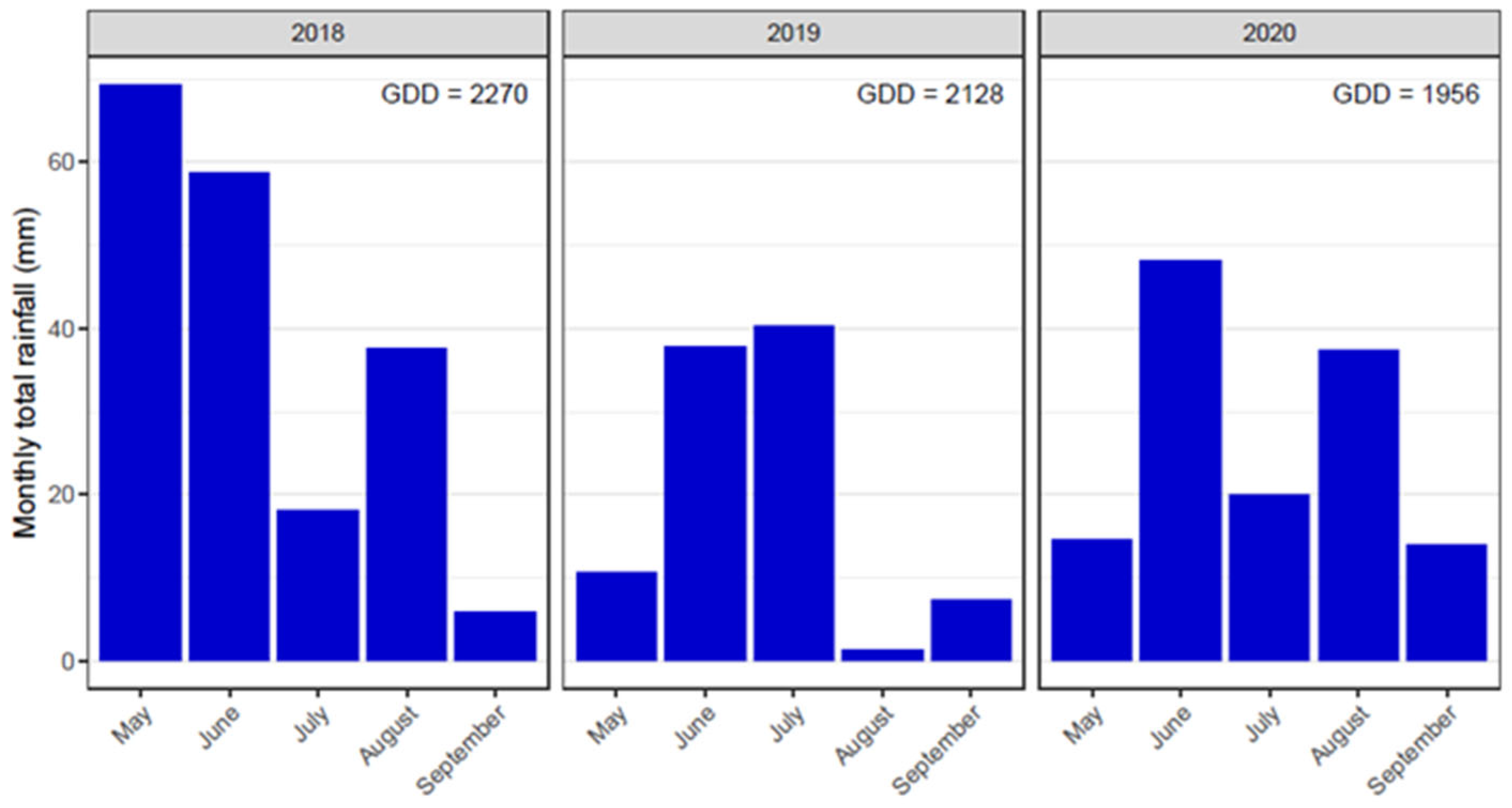

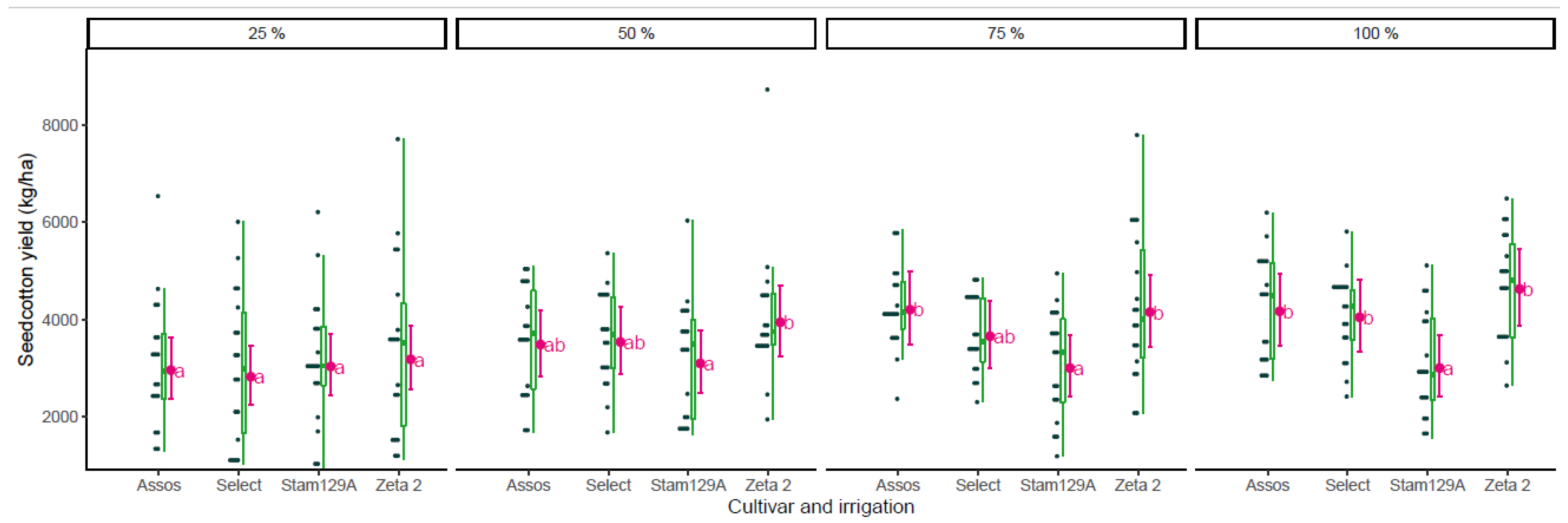
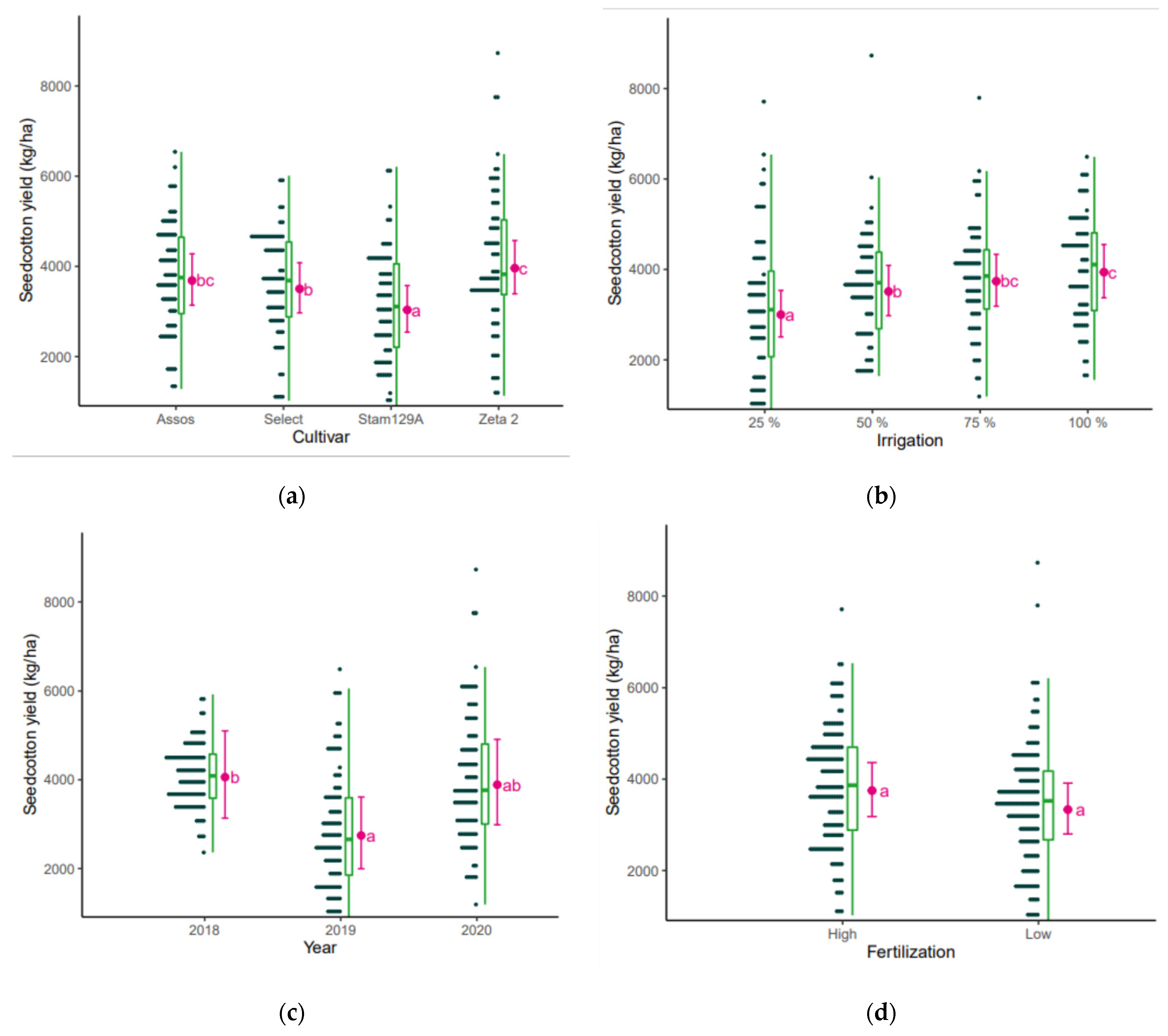
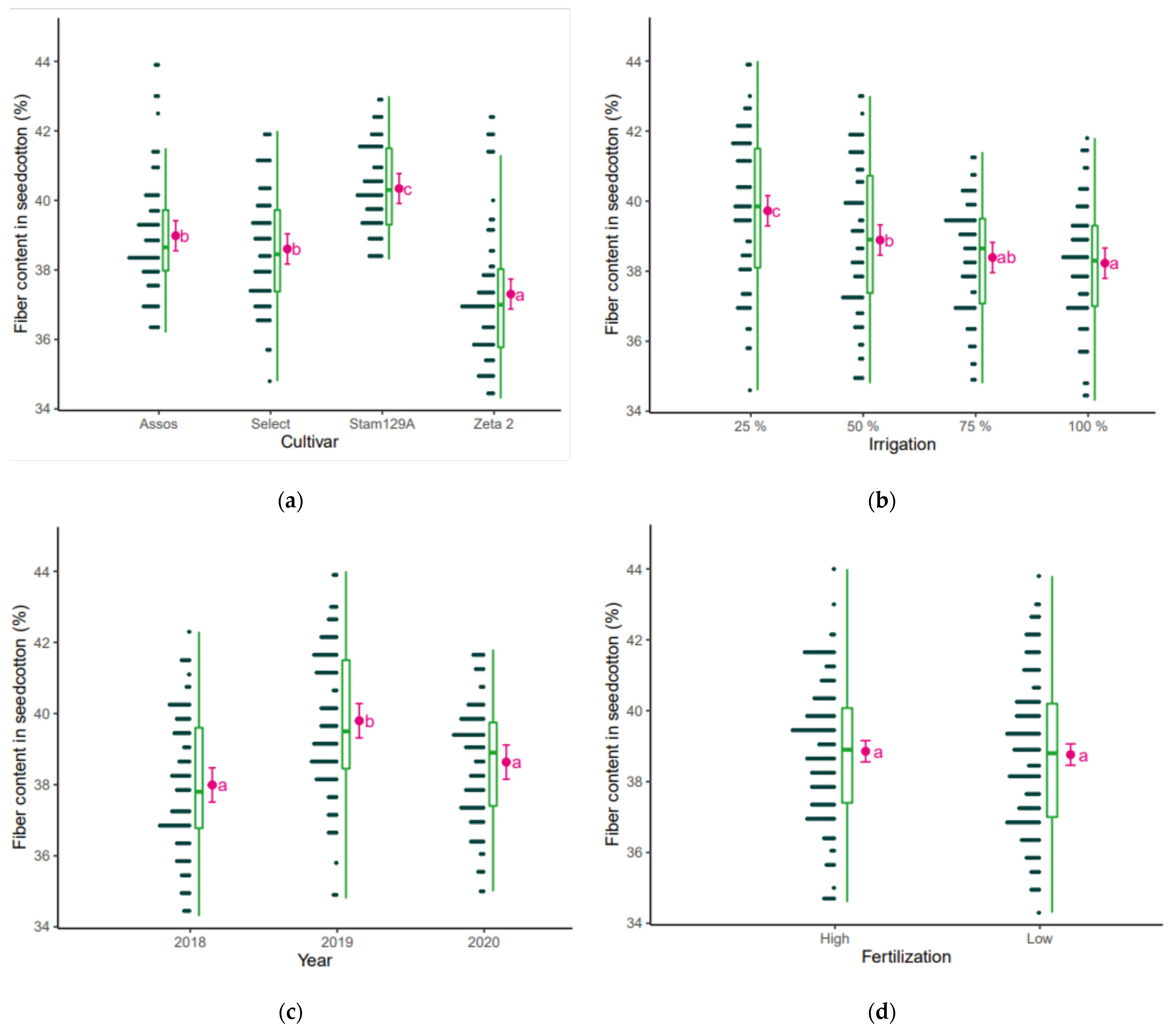

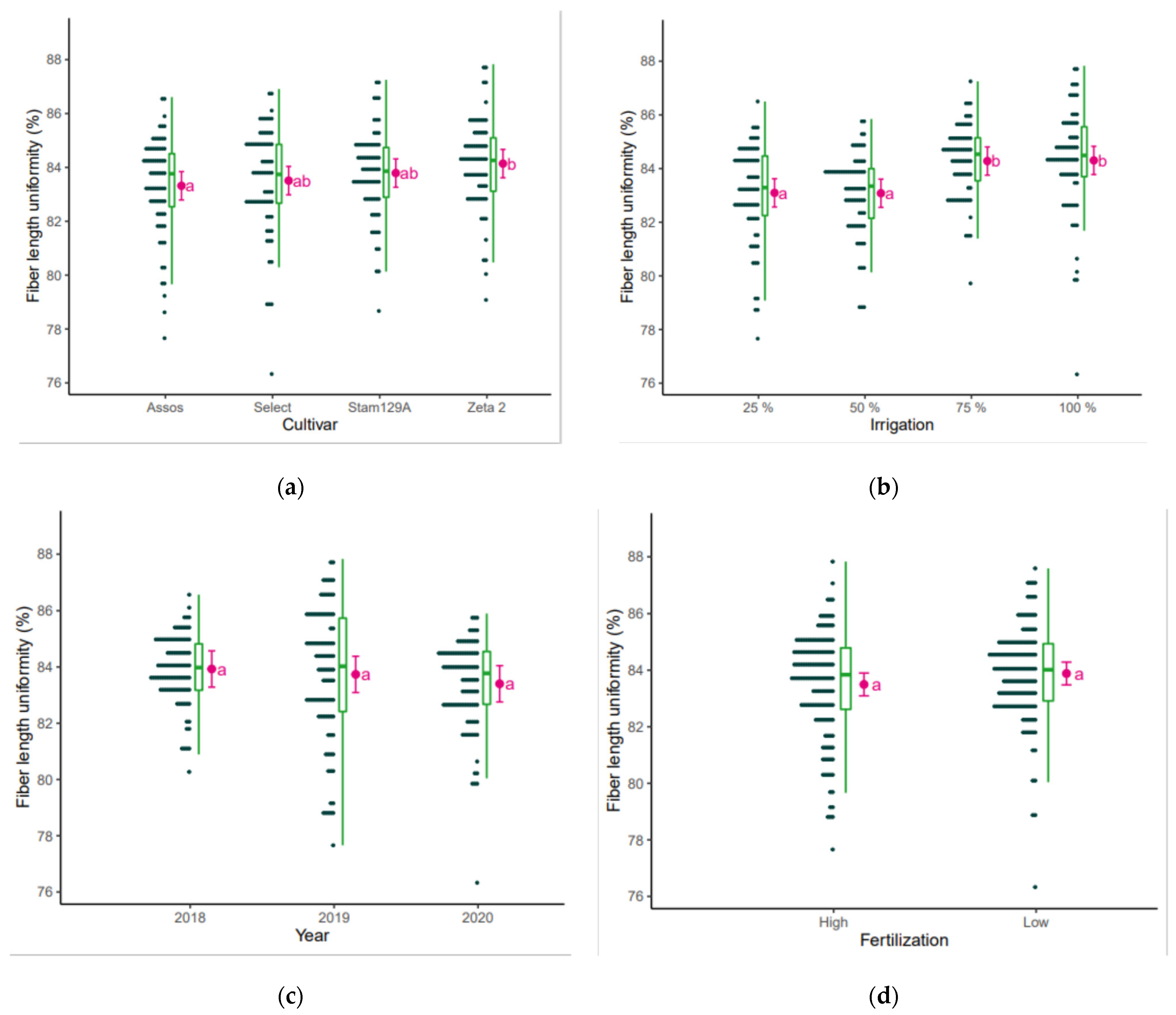

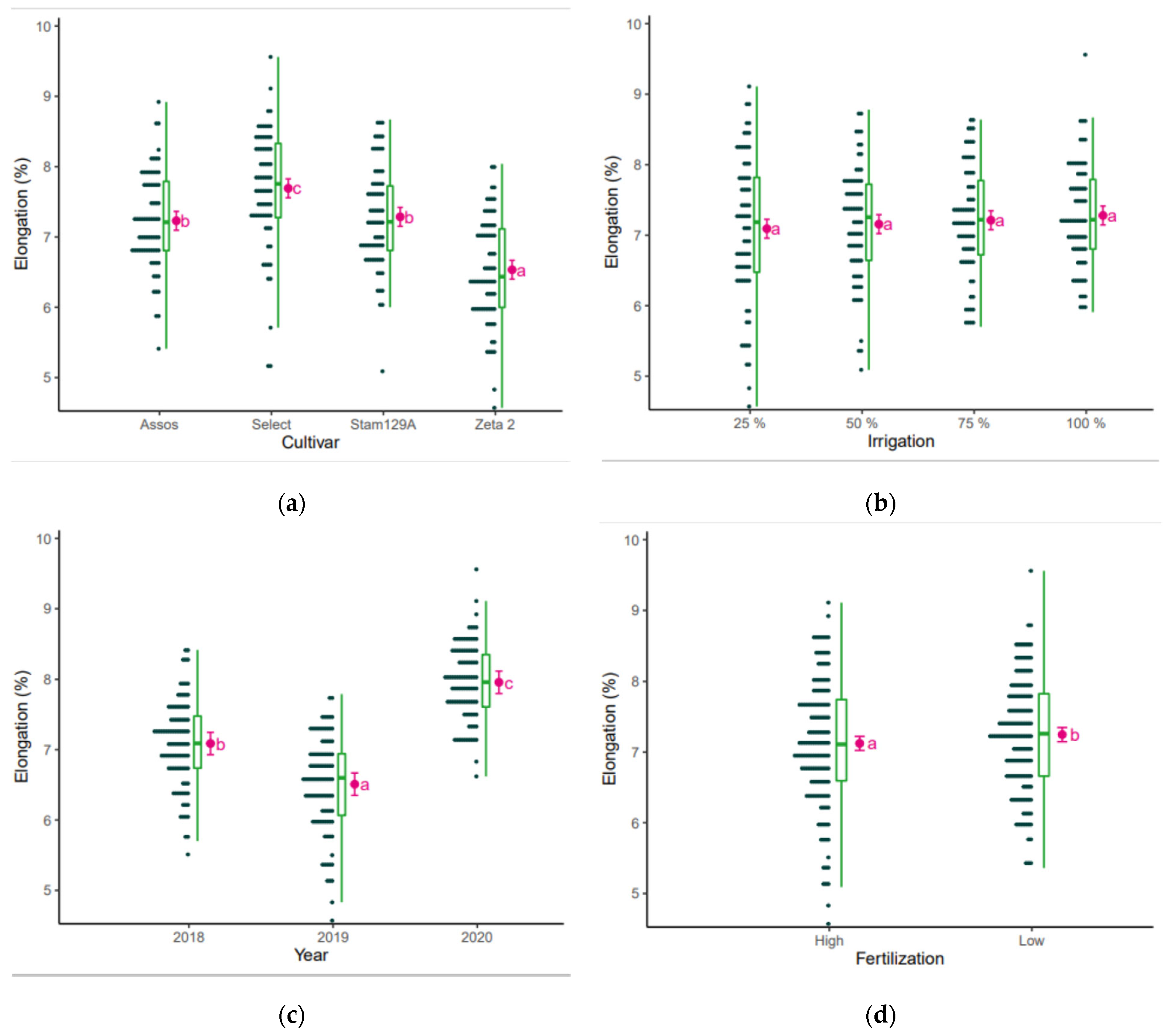
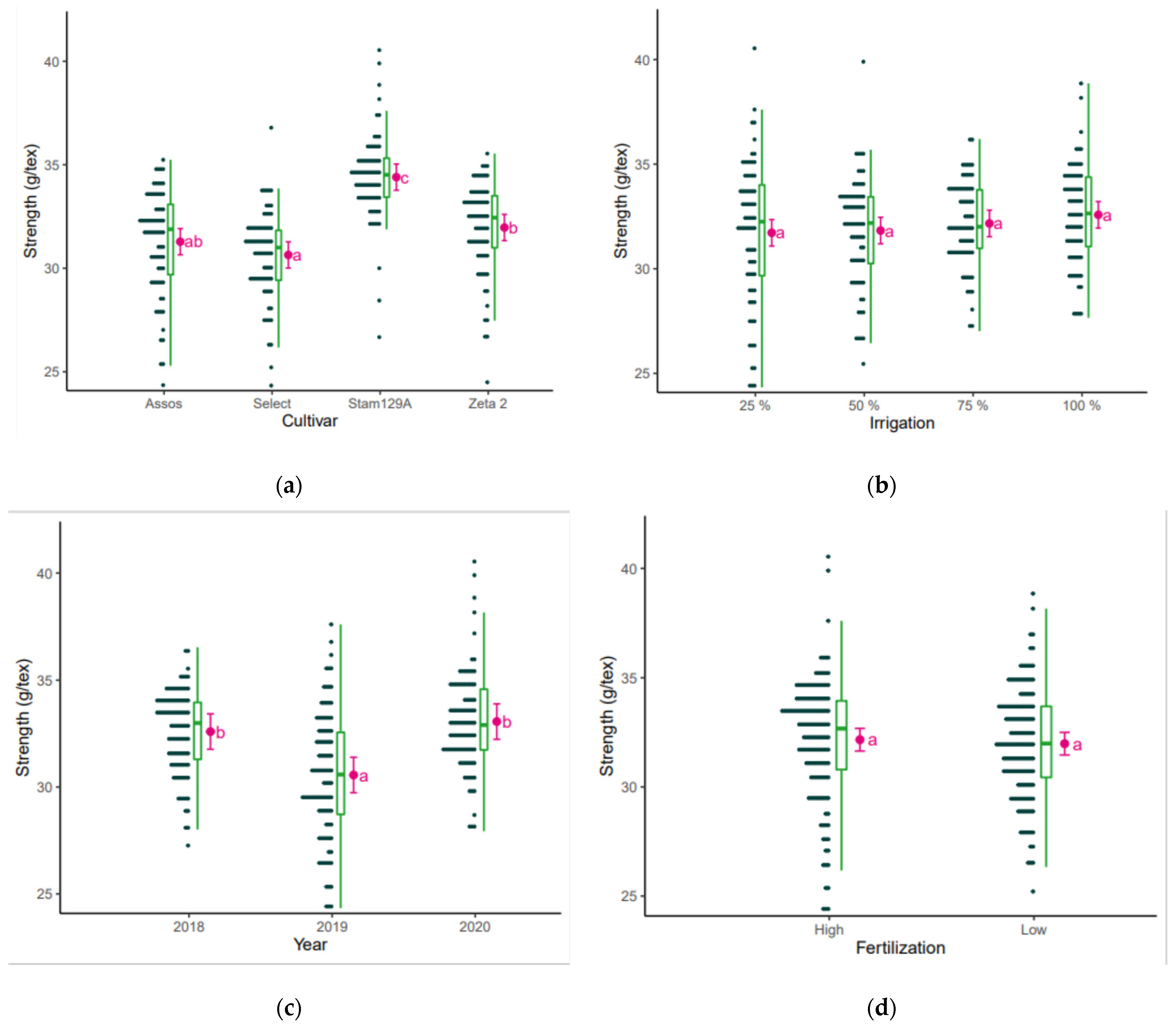
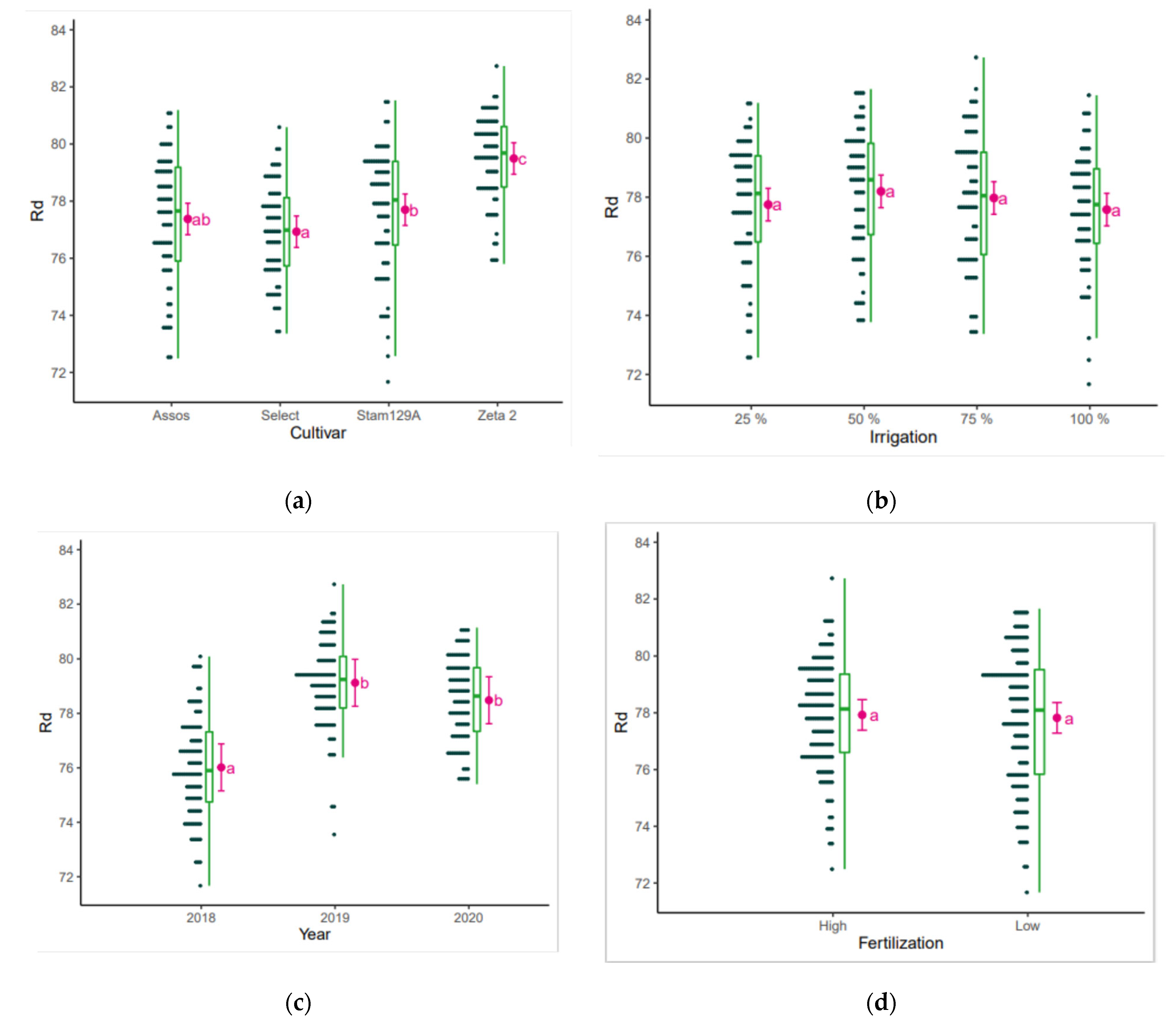
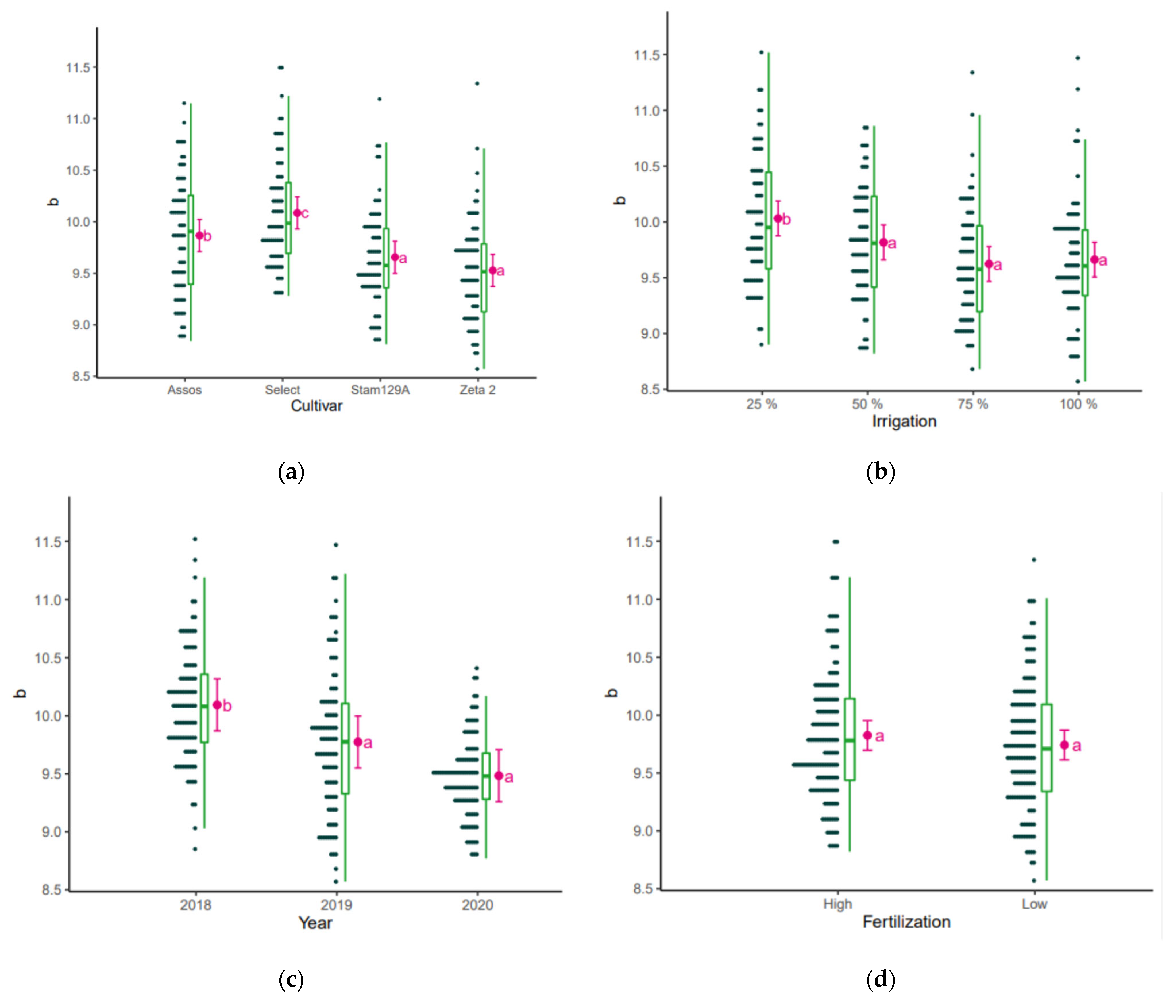
| Soil Parameter | 2018 | 2019 | 2020 |
|---|---|---|---|
| Sand (%) | 47.2 | 48.0 | 44.0 |
| Silt (%) | 33.6 | 36.0 | 38.0 |
| Clay (%) | 19.2 | 16.0 | 18.00 |
| pH | 7.7 | 7.8 | 7.6 |
| Organic matter (%) | 0.40 | 1.60 | 0.58 |
| EC (ms cm−1) | 0.28 | 0.56 | 0.56 |
| ΝO3-Ν (mg Kg−1) | 4.2 | 13.5 | 12.2 |
| P (mg Kg−1) | 2.8 | 13.4 | 3.1 |
| K (mg Kg−1) | 71 | 607 | 134 |
| Before Planting (kg ha−1) | At Squaring Stage (kg ha−1) | |||
|---|---|---|---|---|
| Year/Fertilizer | 12-52-0 | 21-0-0 | 0-0-30 | 33.5-0-0 |
| Normal fertilization | ||||
| 2018 | 200 | 300 | 350 | 120 |
| 2019 | 200 | 200 | 0 | 250 |
| 2020 | 200 | 300 | 350 | 120 |
| Low fertilization | ||||
| 2018 | 100 | 150 | 175 | 60 |
| 2019 | 100 | 100 | 0 | 125 |
| 2020 | 100 | 150 | 175 | 60 |
| Parameter | Fertilization | Irrigation | Cultivar | Year | Fertilization: Irrigation | Fertilization: Cultivar | Irrigation: Cultivar | Fertilization: Irrigation: Cultivar |
|---|---|---|---|---|---|---|---|---|
| Fiber (%) | 0.31 ns | 15.76 *** | 54.36 *** | 38.89 *** | 1.33 ns | 0.88 ns | 0.47 ns | 0.29 ns |
| Seed cotton yield (kg ha−1) | 1.41 ns | 12.19 *** | 14.58 *** | 5.27 * | 0.78 ns | 0.18 ns | 1.98 * | 0.64 ns |
| Micronaire | 0.67 ns | 2.5 ns | 9.6 *** | 27.9 *** | 2.52 ns | 1 ns | 1.86 ns | 0.58 ns |
| Length (mm) | 0.09 ns | 36.39 *** | 5.35 ** | 3.93 ns | 0.07 ns | 0.12 ns | 0.53 ns | 0.41 ns |
| Length uniformity | 2.92 ns | 12.61 *** | 3.34 * | 1.84 ns | 0.44 ns | 0.9 ns | 0.47 ns | 0.74 ns |
| Elongation | 4.94 ns | 2.48 ns | 89.59 *** | 226.71 *** | 2.42 ns | 3.63 * | 0.41 ns | 1.56 ns |
| Strength (g tex−1) | 0.39 ns | 2.96 * | 53.37 *** | 27.72 *** | 2.22 ns | 0.37 ns | 0.71 ns | 1.53 ns |
| Rd | 0.11 ns | 3.34 * | 58.6 *** | 39.05 *** | 1.46 ns | 0.96 ns | 0.8 ns | 0.09 ns |
| b | 1.7 ns | 13.77 *** | 24.06 *** | 20.04 ** | 1.92 ns | 0.1 ns | 0.79 ns | 0.55 ns |
Disclaimer/Publisher’s Note: The statements, opinions and data contained in all publications are solely those of the individual author(s) and contributor(s) and not of MDPI and/or the editor(s). MDPI and/or the editor(s) disclaim responsibility for any injury to people or property resulting from any ideas, methods, instructions or products referred to in the content. |
© 2023 by the authors. Licensee MDPI, Basel, Switzerland. This article is an open access article distributed under the terms and conditions of the Creative Commons Attribution (CC BY) license (https://creativecommons.org/licenses/by/4.0/).
Share and Cite
Tsaliki, E.; Loison, R.; Kalivas, A.; Panoras, I.; Grigoriadis, I.; Traore, A.; Gourlot, J.-P. Cotton Cultivation in Greece under Sustainable Utilization of Inputs. Sustainability 2024, 16, 347. https://doi.org/10.3390/su16010347
Tsaliki E, Loison R, Kalivas A, Panoras I, Grigoriadis I, Traore A, Gourlot J-P. Cotton Cultivation in Greece under Sustainable Utilization of Inputs. Sustainability. 2024; 16(1):347. https://doi.org/10.3390/su16010347
Chicago/Turabian StyleTsaliki, Eleni, Romain Loison, Apostolos Kalivas, Ioannis Panoras, Ioannis Grigoriadis, Abdou Traore, and Jean-Paul Gourlot. 2024. "Cotton Cultivation in Greece under Sustainable Utilization of Inputs" Sustainability 16, no. 1: 347. https://doi.org/10.3390/su16010347
APA StyleTsaliki, E., Loison, R., Kalivas, A., Panoras, I., Grigoriadis, I., Traore, A., & Gourlot, J.-P. (2024). Cotton Cultivation in Greece under Sustainable Utilization of Inputs. Sustainability, 16(1), 347. https://doi.org/10.3390/su16010347






